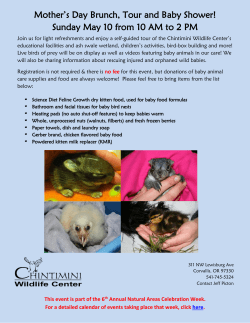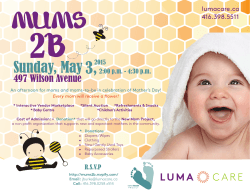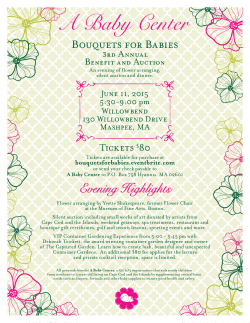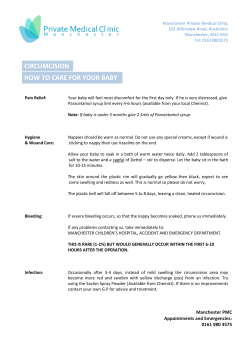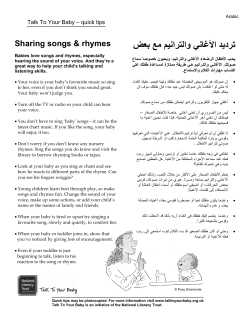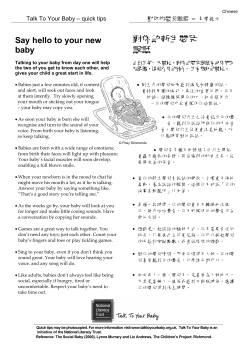
Tips for Dealing with Separation Anxiety for Babies and Toddlers
Tips for Dealing with Separation Anxiety for Babies and Toddlers Play Peek-a-Boo with Objects – Great way to teach your baby an important concept that will allow them to begin to understand the foundation of separation: things exist even if they can’t see them, and when they go, they come back. Hide toys under blankets or containers and then pull them back out with a flourish. When you put something under a blanket, you can sometimes let your baby feel it from the top to show that the object is still there. Let your baby have a turn with hiding too, and then you can find it with a joyful tone. A great variation of this game is to use a toy house and toy people and show them going in and out and around. Show them driving away, going to work or the grocery store. Always show a pleasant good-bye and a happy moment when they arrive back home. Play the game often for the best learning effect. Play Peek-a-Boo with People – This game demonstrates that people still exist even when you can’t see them and that they do return and its fun when they come back. There are many ways to play. You can hide your face behind your hands or a blanket, or even behind your baby’s legs during a diaper change. Stay hidden for a few seconds, and then you might ask, “Where’s Mummy?” Pause while your baby processes the question and then pop out and cheerfully announce, “Peek-a-boo! Here I am!” Over time hide more of your face and then hide for longer periods of time. You can also use an object to cover the baby’s face (“Where’s Baby?”) and then let him/her be the one to pop out. Play the Bye-Bye Game – This game allows the baby to use the typical words and gestures we use when leaving and returning. It helps your baby learn the concepts of “hello” and “bye-bye” and demonstrates what these phases represent. This is how to play: Say, “Bye-Bye” (or whatever words or phrases you typically use when leaving your child) and duck behind a corner or piece of furniture. A few seconds later, pop out and say, “Hi!” (Or use your usual welcoming phrase). Try and play this game daily – staying hidden for longer periods of time. You can extend the game to include times when you leave the room to shower, do laundry or make dinner. You can also let your baby have a turn at hiding. Practice with Quick, Safe Separations during the Day – Over the course of your usual days together take opportunities to expose your baby to a few brief, safe visual ~ Macarthur CDC ~ separations. Begin by getting your child interested in a toy, or game, or another person. When your child is happily engaged in play, walk away slowly and go briefly into another room. Whistle, hum or talk as you go and when you are out of sight so that he/she knows you’re still there, even though the child can’t see you. If they seem nervous, then step away just for a moment and slowly expand the times you step out. Gradually build the length of separation time. Avoid an In-Arms Transfer – Handing the baby from one caregiver to another can cause problems as your child is leaving the safety and warmth of your arms and being physically whisked away to another, less familiar person. This type of parting can be physically painful for children and it is the ultimate separation anxiety producer. To avoid the arms-to-arms transfer, make the change with your baby situated in a neutral place, such as playing on the floor or sitting in a swing, high chair, or baby seat. Have the other caregiver sit next to your baby and engage his/her attention as you say a quick, happy good-bye and leave. As soon as you are gone is the best time for the caregiver to pick up your child. The caregiver is then put in the position of rescuer and that can help build their relationship with your baby. Let your Child Enjoy Some Quiet “Alone Time” in the Crib or Bed – A child can enjoy alone time to learn that she can be his/her own best company. After your child wakes up from a nap or in the morning they may be content to look around the room, play with a toy or daydream, and allow them this time. Listen carefully to your child: Is he/she calling to you or fussing for attention? Or is he/she just waking up to their world and taking a few quiet minutes for themself? If he/she seems content, then keep an ear on him/her, but allow him/her this personal time. Tell your Child What to Expect – Even if you think your little one is too young to understand, get in the habit of telling him where you’re going and when you’ll be back. Letting them know an hour or so before it happens, and then again as you are getting ready to leave is a good practice. E.g. “I’m going to the store soon. You’ll be here with Grandma”. Give them an idea of when you will return. Use an indicator he can understand, such as “I’ll be back after lunch”. Do this even with a preverbal baby, because eventually they will understand. Don’t Sneak Away – Don’t tip toe away when your child is asleep or distracted. It may seem easier than dealing with a tearful good-bye, but it will just cause the child constant worry that you’re going to disappear without warning at any given moment in the future. Result may be more clinginess – because they will assume they must keep you in their sights at all times. It can also diminish their trust in you: they may interpret this as punishment or disrespect of their feelings. Don’t Rush the Parting – Give you baby some time to process your leave-taking. Rushing around in the morning to get the child to day-care can easily set the child up for an episode of anxiety. Create and use a short but pleasant good-bye ritual (certain words and actions you always use when you go. Be Relaxed and cheerful, allow ten or fifteen minutes for a proper, peaceful send-off). ~ Macarthur CDC ~ Don’t Prolong the Parting – While you want to allow your child sufficient time to accept that you are leaving, don’t drag out the actual good-byes too long. The longer you make the parting process the more your child’s anxiety grows. Once you say Good-Bye leave! Don’t stop to talk to the caregiver once you have said good-bye. Express a Cheerful, Positive Attitude when Leaving – If your nervous about leaving them, the child will be nervous as well. Children are very perceptive of their parents’ feelings. When you show your child that you are relaxed and confident, you’re sending a message that they should relax as well. Have Practice Sessions: Leave your Baby with Familiar People – Start with a short time, and then make it progressively longer – ten minutes, twenty minutes, and thirty minutes – until you reach an hour or two. For best results, do this every few days or at least twice a week, so that your baby remembers the experience from one time to the next. - - Try not to return while your baby is crying – wait until the caregiver can calm them, suggest possible activities that would most likely help such as looking out the window, playing with the cat, or reading a book. When you return, don’t make it an emotional reunion: Give him/her a pleasant hug and then ask, “Did you have fun?” This lets your child know you are comfortable and confident with this new arrangement and he/she should be too. Cue the Caregiver’s Helpful Response – Suggest that your caregiver attempt to gain the child’s attention with an active motion, such as cheerful hand clapping, and a distracting tone of voice that matches the volume and emotion of the child’s response. Invite Distractions - Encourage your child’s caregiver to get them involved with a toy or playtime as you leave. If your schedule allows, get them started while you are still there. After a few minutes move away and just watch them quietly, avoid any supportive comments. Once they are engaged say a quick good-bye and go. By allowing your child to be distracted by an interesting toy etc. your leaving is not the focal point. Allow your baby the Separation that they initiate – If your little one crawls or toddles off to another room, don’t rush after them. Peek to be sure they are safe, of course, but let him/her know it is fine to go off exploring on their own. This encourages independence, self-confidence, creativity and language skills. Eat, Drink, Rest and Be Merry - A child who is well rested will make new friends or adapt to a parting from Mum or Dad much easier than a tired one. ~ Macarthur CDC ~ When meeting new people: Introduce them gently – hold your baby securely in your arms when meeting a new person, makes them feel more comfortable with the unknown. Don’t force them to be held or touched by others. Understand the people familiar to you may be strangers to your baby – if your baby hasn’t seen much of the people in your life, (grandpa, aunty etc.) they will categorise them as strangers. Let people know the child takes a while to warm up to people to aid with the discomfort felt. Let your Baby Set the Pace – Encourage the new person to ignore your baby and wait for the baby to come to them. Give the guest a toy to share with the child. Let your Baby Safely Observe More New People – The more your baby is around new people, the more comfortable he’ll be with new faces. Expose your child to groups of people in places where they can observe without the pressure to interact. Rescue your Baby as soon as they need you – Allowing them a rescue when they call for it means they will be willing to try again. Short, pleasant experiences will naturally grow into longer one. ~ Macarthur CDC ~
© Copyright 2025
